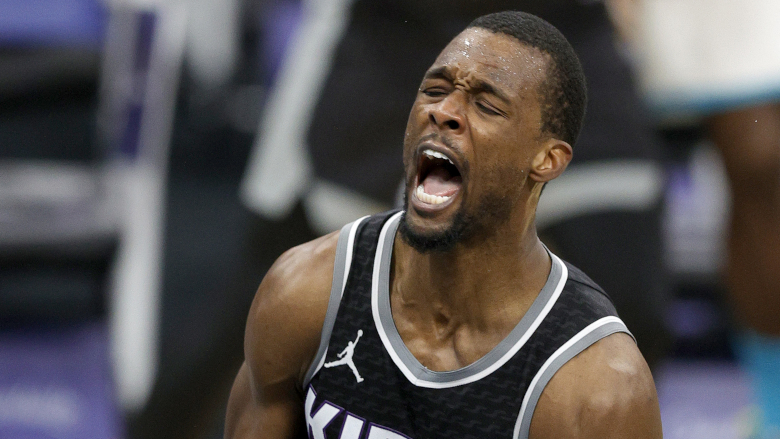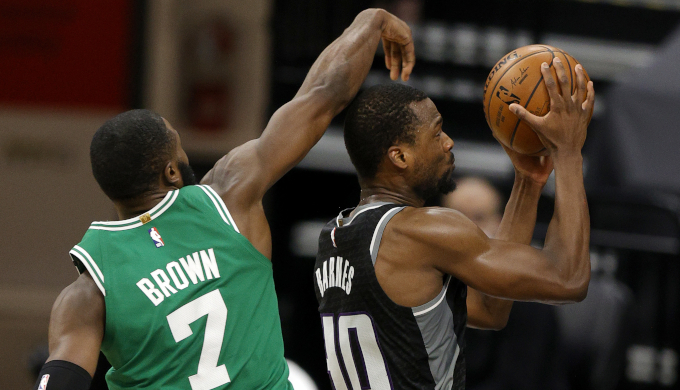
On Tuesday night, the Boston Celtics lost in heartbreaking fashion to the hot-shooting Utah Jazz after an uneven fourth-quarter effort. As noted by MassLive’s Brian Robb, the loss dropped the Cs to 0-8 against the teams that currently hold the NBA’s five best records.
Clearly, the team has been playing better of late, winning five of its previous six games before losing to the Jazz. And even against Utah — which remains the winningest squad in the Association — the Celtics were extremely competitive.
However, that 0-8 mark against elite competition speaks volumes about Boston’s overall firepower (or lack thereof) behind its top dogs.
With the NBA trade deadline fast approaching, a number of names have been bandied about in Beantown as players who could help take the Celtics to another level. Most notably, Sacramento Kings forward Harrison Barnes has been namechecked as a top target for Celtics GM Danny Ainge.
But even if he finds himself in a position to deal for the rangy big man, would that move in and of itself be enough to turn the tide for the Celtics?
A new trade simulation says yes.
Simulation Predicts a Major Uptick After Barnes Trade
As part of the outlet’s “What if Wednesdays” series, NBC Sports Boston partnered with Strat-O-Matic to see just what kind of difference Barnes could make in a potential move to the Massachusetts Bay. Using its simulation software, the firm executed a virtual trade for the playmaking veteran and then played out the remainder of the 2020-21 season.
In a word, the results were impressive.
Per the terms of the virtual deal, the Celtics sent out Romeo Langford and their 2021 first-round pick for Barnes. It was a pact that worked well in Boston’s favor as the franchise retained all of its core players. And while the simulation saw Barnes’ number taking a slight dip in his new digs, he still made a significant contribution.
Per the sim, Barnes started in all of the Celtics’ post-trade games, averaging a hefty 32 minutes per night and putting up 12.9 points, 4.7 rebounds and 2.0 assists per contest. He also connected on 35.4 percent of his triples. As a result, Boston went 24-10 down the stretch to finish with a 44-28 record and the No. 5 seed in the Eastern Conference.

GettyHarrison Barnes of the Kings takes the ball to the hoop against the Boston Celtics’ Jaylen Brown.
Strat-O-Matic’s simulated results for the remainder of the season featured full stat lines for every player on the Celtics’ roster, including box scores for each game and a full playoff sim.
In the postseason, the simulation saw the Celtics beating the Miami Heat in the first-round in what was an exciting seven-game series. However, Boston was ultimately felled in the Eastern Conference semifinal by Giannis Antetokounmpo and the Milwaukee Bucks in a six-game series.
Conclusion
Even before this simulation was put out into the world, the idea that adding a versatile, playmaking big man would help the Celtics was hardly a hot take. The same could be said for half of the teams in the Association, and Barnes is probably at or near the top of their respective lists.
On the other hand, a simulation is not real life and this one has a few inherent flaws. Namely, it assumes no other deals are being made league-wide and it is making guesses on the injury front.
Still, the latest “What if Wednesday” goes to show that a Barnes trade makes a lot of mathematical sense.
Whether or not a deal with the Kings is actually in the cards remains to be seen.
READ NEXT: Celtics ‘Not Interested’ in Trading for 7x NBA All-Star
Comments
Trade Simulation Sees Celtics Soaring After Dealing for Top Target